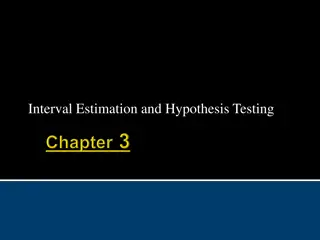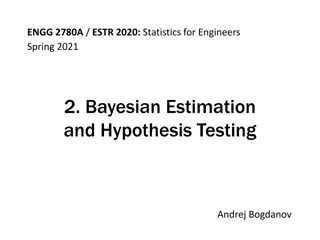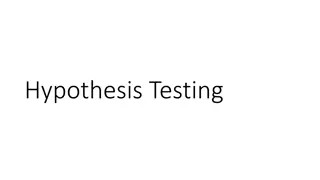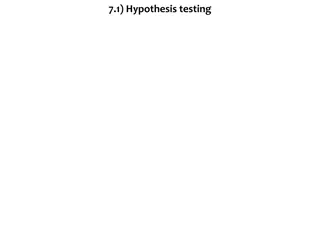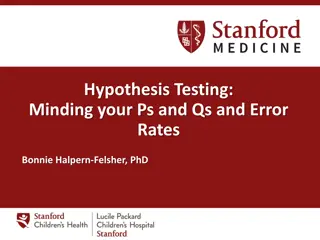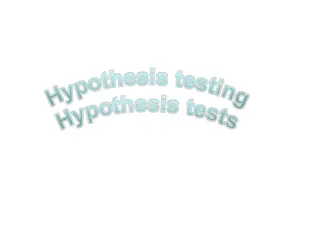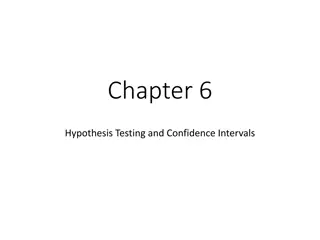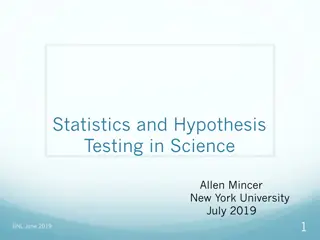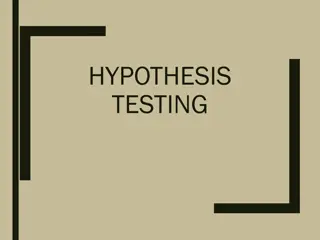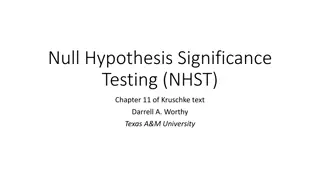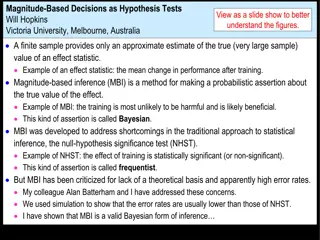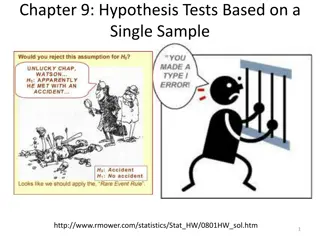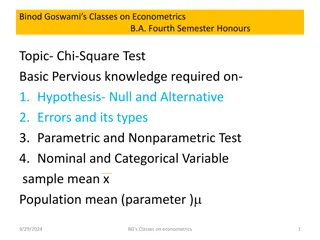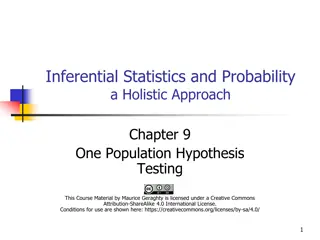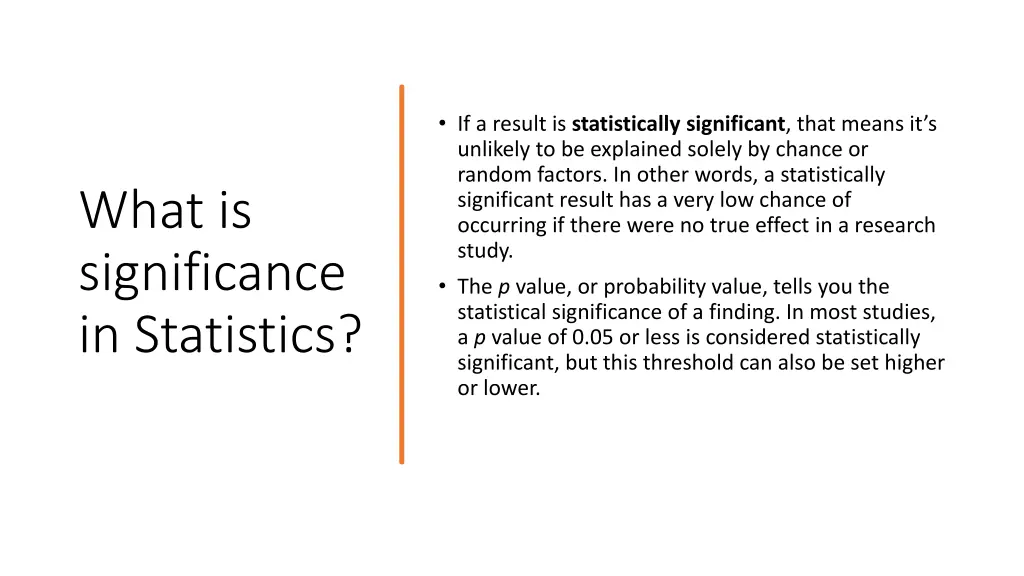
Understanding Statistical Significance in Research Studies
Learn about statistical significance in research, including the concept of p-values, significance levels, and the difference between one-tailed and two-tailed tests. Discover how researchers determine the likelihood of results occurring by chance and interpret the importance of statistical significance in drawing valid conclusions.
Uploaded on | 1 Views
Download Presentation

Please find below an Image/Link to download the presentation.
The content on the website is provided AS IS for your information and personal use only. It may not be sold, licensed, or shared on other websites without obtaining consent from the author. If you encounter any issues during the download, it is possible that the publisher has removed the file from their server.
You are allowed to download the files provided on this website for personal or commercial use, subject to the condition that they are used lawfully. All files are the property of their respective owners.
The content on the website is provided AS IS for your information and personal use only. It may not be sold, licensed, or shared on other websites without obtaining consent from the author.
E N D
Presentation Transcript
If a result is statistically significant, that means its unlikely to be explained solely by chance or random factors. In other words, a statistically significant result has a very low chance of occurring if there were no true effect in a research study. The p value, or probability value, tells you the statistical significance of a finding. In most studies, a p value of 0.05 or less is considered statistically significant, but this threshold can also be set higher or lower. What is significance in Statistics?
Level of Significance The significance level, or alpha ( ), is a value that the researcher sets in advance as the threshold for statistical significance. It is the maximum risk of making a false positive conclusion (Type I error) that you are willing to accept. In a hypothesis test, the p value is compared to the significance level to decide whether to reject the null hypothesis. If the p value is higher than the significance level, the null hypothesis is not refuted, and the results are not statistically significant. If the p value is lower than the significance level, the results are interpreted as refuting the null hypothesis and reported as statistically significant.
Level Of significance Cont.. Usually, the significance level is set to 0.05 or 5%. That means your results must have a 5% or lower chance of occurring under the null hypothesis to be considered statistically significant. It s important to note that hypothesis testing can only show you whether or not to reject the null hypothesis in favor of the alternative hypothesis. It can never prove the null hypothesis, because the lack of a statistically significant effect doesn t mean that absolutely no effect exists.
The p-value, or probability value, tells you how likely it is that your data could have occurred under the null hypothesis. It does this by calculating the likelihood of your test statistic, which is the number calculated by a statistical test using your data. The most common threshold is p < 0.05; that is, when you would expect to find a test statistic as extreme as the one calculated by your test only 5% of the time. But the threshold depends on your field of study some fields prefer thresholds of 0.01, or even 0.001. p-value
The two ways of carrying out statistical significance test of a characteristic, drawn from the population, with respect to the test statistic, are a one-tailed test and two-tailed test. One / Two tailed Tests The one-tailed test refers to a test of null hypothesis, in which the alternative hypothesis is articulated directionally. Here, the critical region lies only on one tail. However, if the alternative hypothesis is not exhibited directionally, then it is known as the two-tailed test of the null hypothesis., wherein the critical region is one both the tails.
The two ways of carrying out statistical significance test of a characteristic, drawn from the population, with respect to the test statistic, are a one-tailed test and two-tailed test. One / Two tailed Tests The one-tailed test refers to a test of null hypothesis, in which the alternative hypothesis is articulated directionally. Here, the critical region lies only on one tail. However, if the alternative hypothesis is not exhibited directionally, then it is known as the two-tailed test of the null hypothesis., wherein the critical region is one both the tails.
One-tailed test alludes to the significance test in which the region of rejection appears on one end of the sampling distribution. It represents that the estimated test parameter is greater or less than the critical value. When the sample tested falls in the region of rejection, i.e. either left or right side, as the case may be, it leads to the acceptance of alternative hypothesis rather than the null hypothesis. It is primarily applied in chi-square distribution; that ascertains the goodness of fit. In this statistical hypothesis test, all the critical region, related to , is placed in any one of the two tails. One-tailed test can be: Left-tailed test: When the population parameter is believed to be lower than the assumed one, the hypothesis test carried out is the left-tailed test. Right-tailed test: When the population parameter is supposed to be greater than the assumed one, the statistical test conducted is a right-tailed test. One Tailed Tests
The two-tailed test is described as a hypothesis test, in which the region of rejection or say the critical area is on both the ends of the normal distribution. It determines whether the sample tested falls within or outside a certain range of values. an alternative hypothesis is accepted in place of the null hypothesis, if the calculated value falls in either of the two tails of the probability distribution. is bifurcated into two equal parts, placing half on each side, i.e., it considers the possibility of both positive and negative effects. The two extreme values, work as evidence against the null hypothesis. Two Tailed Tests

